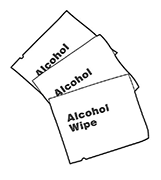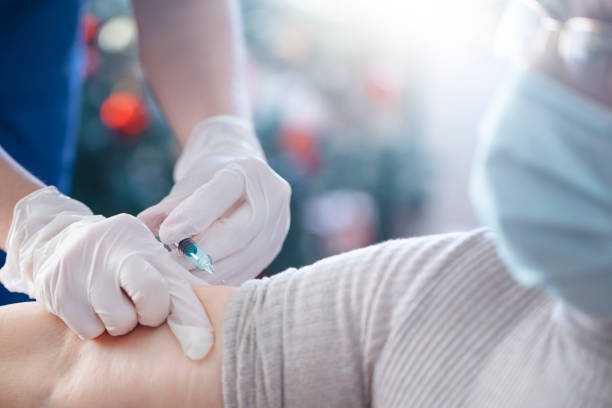1
THE CORRECT ANGLES AND WAYS TO HOLD THE SYRINGE
A Subcutaneous (SQ) Injection is given in the fatty layer of tissue just under the skin. Syringes for Subcutaneous injections will use smaller needles than those used for injections into a muscle. The typical Insulin or TB syringes will have 1/2 inch or less needle length because it only needs to go slightly below the skin level. Only certain types of injections can be given through this route.
Subcutaneous injections can be given straight and at a 90-degree angle, or at a 45-degree angle. You can give the shot at a 90-degree angle if 2 inches of skin can be grasped between your thumb and first (index) finger. If only skin can be grasped, give the shot at a 45-degree angle.

2
SITES ON THE BODY…
There are many sites on the body that are safe to give subcutaneous shots.
Upper Arm:
Uncover the arm to the shoulder to see the whole arm. Have the person receiving the subcutaneous injection stand with hand on hip. Stand next to and a little behind the person. Find the area in the middle part of the arm, halfway between the elbow and shoulder. Gently grasp the skin at the back of the arm between your thumb and first 2 fingers. You should have 1-2 inches of skin.
Abdomen:
Uncover the abdomen to see the whole area. Find the waist area. You may give a shot bounded by these landmarks below the waist, to just above the hip bone, and from where the body curves at the side to about 2 inches from the middle of the abdomen. Use the natural line in the middle of the body as a marker. It may be hard to see, but it is there unless it was covered by surgery. Avoid the surrounding area 2 inches from the belly button.
Thigh:
Uncover the entire leg and the area between the knee and hip. The middle of the thigh, from mid-front to mid-side, on the outside part of the thigh, is a safe site. Gently grasp the area to make sure you can pinch 1-2 inches of skin.

3
HOW DO I INJECT MEDICATION INTO SUBCUTANEOUS TISSUE?
Please read the section all the way through before giving the subcutaneous injection. It is important to get a general idea of what you are about to do before you begin. You may read this step-by-step procedure again as you do it.
1. Wash your hands thoroughly with soap and dry them completely.
2. Open the foil covering the alcohol wipe.
3. Wipe the area where you plan to give the shot. Let the area dry.

4. Take the cover off the needle. Hold the syringe with your writing hand and pull the cover off with your other hand, like taking a cap off a pen.
5. If you will give the shot at a 45-degree angle, hold the syringe with your writing hand. Place the syringe between your thumb and your index and second fingers. The bevel of the needle should be pointing upwards at the 45-degree angle you plan to use.
6. If you will give the shot at a 90-degree angle, hold the syringe with your writing hand. Hold the syringe under your thumb and first finger. Let the barrel of the syringe rest on your second finger. (Many people hold a pen this way when they write).
7. Grasp the skin with the hand not holding the syringe. Holding the syringe barrel tightly with your writing hand, use your wrist to insert the needle through the skin. Sometimes the needle goes in easily. Some people have tougher skin and a little more pressure or quickness will be required.
8. Once the needle is all the way in, push the plunger down slowly to inject the syringe’s contents.
9. Remove the needle at the same angle you put it in.
10. Dispose of the syringe and needle in a Sharps Container.
4
THE CORRECT ANGLES AND WAYS TO HOLD THE SYRINGE

The correct size needle and syringe

Vial containing the medication

One alcohol wipe

You may want to use gloves for your protection or the protection of the person receiving the subcutaneous injection
5
HOW CAN I GET RID OF USED SYRINGES AND NEEDLES?
You can purchase a Sharps Container, which is a hard-plastic container made especially for used syringes and needles, at your local pharmacy. If you did not purchase this container with your medication, you can use a hard-plastic container with a screw-on top such as a clothing softener or hard plastic detergent bottle. Make sure you can easily put both the syringe and the needle into the container.
Whatever container you choose, make sure that othe needles cannot break through the sides, bottom, or top.
Call your primary care physician or your local pharmacy to find out what your state or local requirements are for disposing of used syringes and needles.

Many treatments come in the form of shots that are administered directly into your vein or just beneath your skin. You might be wondering about subcutaneous injections, and why these shots hurt so much less than ones given directly into a vein. Let us explain this practice and how it can help ease pain from an illness or injury. Whether you’ve been self-administering intra-muscular injections or completely new to self-injections, this article covers everything you need to know about subcutaneous injections and how they work.
What is a subcutaneous injection?
A subcutaneous injection is a way of administering medication, fluids, or blood that is injected into the tissue just below the skin. This can be done by or a needle, depending on the situation and type of medication you are administering. Subcutaneous injections are given outside the veins (IV). They administer fluid or medication that travels slowly through the body. This is a great option for patients who may be frightened by a needle going into their vein or muscle. Subcutaneous injections are often used to administer vaccines, medications, or fluids as part of chemotherapy that cannot be taken orally, or when an individual has an allergy or sensitivity to the ingredients in the medication.
How do subcutaneous injections work?
A subcutaneous injection is a way of administering medication, fluids, or blood that is injected into the tissue just below the skin. This can be done by or a needle, depending on the situation and type of medication you are administering. Subcutaneous injections are given outside the veins (IV). They administer fluid or medication that travels slowly through the body. This is a great option for patients who may be frightened by a needle going into their vein or muscle. Subcutaneous injections are often used to administer vaccines, medications, or fluids as part of chemotherapy that cannot be taken orally, or when an individual has an allergy or sensitivity to the ingredients in the medication.
Benefits of Subcutaneous Injections
- Easier and painless: If you are afraid of needles, subcutaneous injections may be the best option as they are easier to administer and far painless compared to an intra-muscular injection.
- Multiple injections without being hooked up to a machine: If you have to undergo multiple injections, subcutaneous injections may be advantageous to you.
- Easier with allergies: Subcutaneous injections are often preferred by patients with severe allergies to medications, as they allow the patient to receive treatment without having to deal with the allergic reaction.
- No Inflatable Needle: The subcutaneous injection method uses a special syringe that has a smaller needle that is more comfortable when injected into the skin.
How to administer a subcutaneous injection?
If you’ve been prescribed a subcutaneous injection and you’ve never done this before, there’s no need to worry. Administering a subcutaneous injection is actually quite easy and takes a matter of minutes. You should be able to administer the injection on your own or with a little help from a friend or family member. Just follow the steps shown above with the reference diagrams. It’s very important that you clean the injection site before administering the injection, so be sure to clean the injection site with an alcohol swab. This will help prevent infections and irritation. Hold the syringe correctly with the needle facing you. Place the needle at the injection site push down until the syringe is filled with the proper amount of fluid. Remove the syringe and place an adhesive bandage over the injection site. Finally, dispose of the syringe properly so that it doesn’t hurt anyone.
Side Effects of Subcutaneous Injections
- Bruising: One side effect of subcutaneous injections is bruising at the injection site. This can often be avoided by applying a warm compress to the injection site for up to 10 minutes after the injection.
- Inability to properly use a long-term pump: A subcutaneous injection may interfere with the proper use of a long-term pump that is used to deliver medication directly into the bloodstream. This is rare, however, and subcutaneous injections are generally safe for long-term use.
Conclusion
Subcutaneous injections are delivered directly under the skin through a small needle. They are typically used for vaccinations, chemotherapy, or other medications that can’t be safely administered intravenously or are more convenient to deliver this way. Subcutaneous injections are often preferred by patients with severe allergies to medications, as they allow the patient to receive treatment without having to deal with the allergic reaction. An injection just below the skin is often preferred by children who are afraid of needles, and subcutaneous injections are often used to administer vaccines. Subcutaneous injections are also used when someone has an allergy or sensitivity to the ingredients in the medication.
Note HRT Doctors is a nationwide Telemedicine Clinical Practice specializing in Hormone Replacement Therapy (HRT) and Testosterone Replacement Therapy (TRT). Board Certified HRT Doctors provide convenient and more affordable access to quality care. In case you have any sort of medical question, or you are looking for medical advice, don’t hesitate to reach out and schedule a free consultation.

